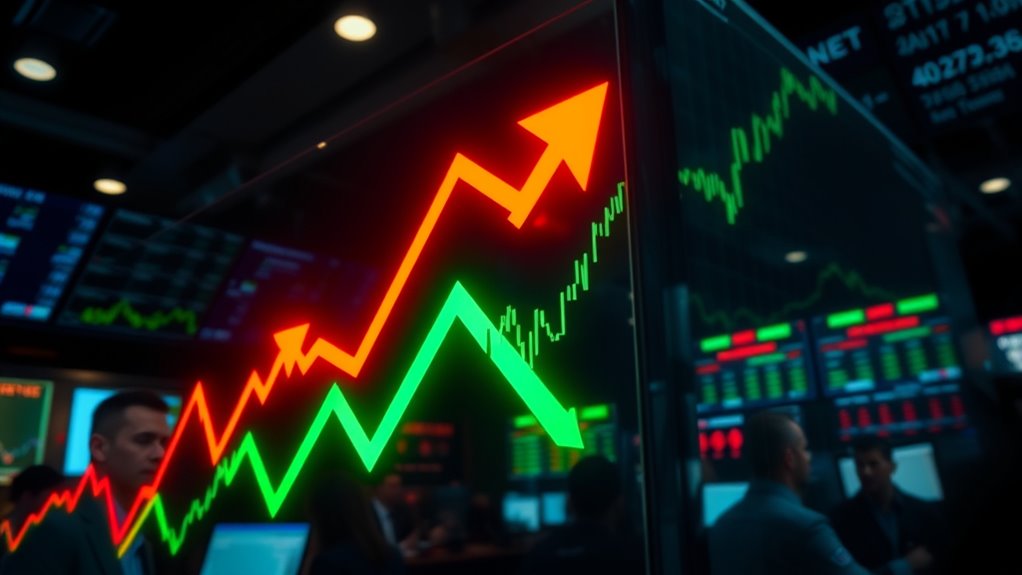The stock market’s facing significant volatility, with the Dow Jones and S&P 500 experiencing sharp declines. Economic factors like inflation and interest rates are impacting investment decisions. While tech stocks struggle, sectors like healthcare and aerospace are thriving. European markets are outperforming their U.S. counterparts, showing a shift in dynamics. These trends reflect the need for a careful approach to investing, and there’s more to uncover about strategies that can help you navigate this landscape effectively.
Key Takeaways
- Recent market volatility resulted in significant declines in major indices, with the Nasdaq dropping 8.1% amidst concerns about tariffs and government policies.
- Strong GDP growth and low unemployment boost investor confidence, contrasting with high inflation’s negative impact on consumer spending and stock prices.
- The healthcare and aerospace sectors show notable gains, while the tech sector faces major losses, indicating shifting investment dynamics.
- Diversification strategies, including alternative investments like Gold and Bitcoin IRAs, are essential for reducing risk and enhancing portfolio security.
- Monitoring geopolitical risks and economic indicators is crucial for making informed investment decisions in today’s uncertain market landscape.
Recent Market Performance and Volatility

As investors grapple with recent market fluctuations, it’s clear that the landscape has shifted significantly since the start of 2025.
The Dow Jones has dropped 2.5%, while the S&P 500 and Nasdaq have seen larger declines of 4.1% and 8.1%, respectively. Market volatility largely stems from concerns about tariffs and government policies, leaving many investors uncertain. Interestingly, while the tech sector struggles, real estate, Consumer Staples, and Utilities have shown resilience, with real estate up 4.18%. Overall economic strength helped stocks bounce back despite investor concerns. Additionally, some investors are looking towards alternatives such as Gold IRAs for diversification in uncertain times. Diversification can help mitigate risk during turbulent periods. In light of these shifts, many are also considering Bitcoin IRAs as a means to secure their retirement portfolios, especially as regulatory compliance becomes increasingly important to navigate this evolving landscape.
The S&P 500 briefly entered correction territory, highlighting the extent of market pullbacks.
Meanwhile, European markets have outperformed U.S. markets, underscoring a significant shift in investment dynamics as global economic conditions evolve.
Economic Influences Impacting Investment Decisions

Market fluctuations aren’t just influenced by immediate events; broader economic factors play a significant role in shaping investment decisions.
For instance, a strong GDP suggests a healthy economy, encouraging you to invest as companies are likely to profit. Conversely, high inflation can squeeze consumer spending, negatively impacting stock prices. Maintaining a stable economy can help prevent instances of running dry, which can affect investor sentiment. Moreover, gold investment strategies can serve as a hedge against inflation and market volatility, providing an additional layer of security for investors. Additionally, indexed annuities can offer a level of protection against inflation through market-related returns, appealing to those looking for stable income.
Low unemployment rates often boost investor confidence, while increased consumer spending signals economic strength. Interest rates matter too; lower rates make borrowing cheaper, stimulating growth and making stocks more appealing, whereas higher rates can deter investment. Additionally, interest rates play a dual role, influencing both the economy and the stock market. Furthermore, an emerging focus on sustainability and responsible investing is becoming a key factor in shaping investor preferences and market dynamics.
Low unemployment and rising consumer spending enhance investor confidence, while interest rates play a crucial role in investment appeal.
Additionally, geopolitical events and political changes can create uncertainty, influencing your decisions. Staying informed about these economic indicators helps you navigate the market effectively and make sound investment choices.
Sector Analysis: Winners and Losers

While various sectors of the stock market are experiencing distinct performances, understanding the winners and losers can provide valuable insights for your investment strategy.
The healthcare sector shines, with CVS Health Corp rebounding significantly, gaining 25.8% in January 2025. Aerospace also thrives, driven by strong results, with GE Aerospace up 22%. This month, the overall S&P 500 gained 2.8%, reflecting positive investor sentiment amidst these sector-specific dynamics. Additionally, the impact of automation on business intelligence has enabled companies to make more informed decisions, contributing to overall sector performance. Furthermore, currency fluctuations can greatly influence investment decisions as they affect the profitability of companies operating internationally. Furthermore, investing in energy-efficient systems like heat pumps can lower operational costs in the long run, appealing to environmentally conscious investors. The growing interest in solar energy solutions demonstrates a shift towards sustainable practices that can enhance long-term investment returns.
However, the technology sector struggles, featuring major losses from companies like Alphabet and Meta. Consumer staples face challenges too, with subdued spending impacting performance.
On the flip side, Mink Therapeutics and Yoshiharu Global Co show remarkable gains, rising 690.10% and 475.08%, respectively.
As you assess your portfolio, consider these dynamics to identify potential opportunities and risks in the market.
Global Market Trends and Comparisons

How do global market trends shape your investment decisions? Understanding the current economic landscape is crucial.
The U.S. remains a growth engine with a strong labor market, while Europe’s stagnation poses risks. Japan’s controlled inflation offers potential, but China’s cooling property market raises concerns. Trend analysis can help investors assess these international trends and make informed decisions. Additionally, predictive modeling can enhance decision-making by analyzing economic data to forecast market movements. Furthermore, RMD rules can also influence retirement investment strategies as they dictate when and how much must be withdrawn from retirement accounts. It is essential to consider diversification across sectors to mitigate risks in a fluctuating market. Moreover, investing in cryptocurrencies like Dogecoin and Shiba Inu can offer high growth potential in a volatile market.
High equity valuations in the U.S. can be daunting, yet market volatility creates opportunities, especially in sectors like AI and healthcare.
Keep an eye on the strong U.S. dollar, which affects emerging markets and trade dynamics. As inflation cools, interest rate adjustments may influence your strategies.
Lastly, be mindful of geopolitical risks and policy changes, as they can significantly impact market sentiment and economic performance globally. Stay informed to navigate these complexities effectively.
Strategic Investment Insights for Today’s Market

Navigating today’s investment landscape requires a keen understanding of strategic approaches that align with your financial goals.
Diversification is essential; spreading investments across various asset classes can reduce risk and enhance potential returns. Bitcoin ETPs are providing new avenues for diversification in the digital asset space. Additionally, incorporating Bitcoin IRAs can further diversify your retirement portfolio and provide tax advantages. Implementing risk assessment tools can help you evaluate and adjust your investment strategies effectively. Furthermore, understanding compliance requirements is crucial for maintaining the integrity of your investment strategy. It’s also vital to consider current legal regulations as they can impact your investment decisions significantly.
Consider active management to adjust your portfolio based on current market conditions, or embrace passive investing through index funds for long-term growth.
Stay vigilant about risk management by implementing strategies that mitigate losses during volatile periods, such as utilizing stablecoins to shield your investments.
Focus on corporate earnings and economic indicators, as they can significantly influence your investment decisions.
Utilize tools like trend analysis and thematic ETFs to capture emerging opportunities, especially in technology and sustainable solutions.
Future Outlook: Navigating Economic Uncertainty

As economic uncertainty looms over the market, understanding its implications is crucial for making informed investment decisions. The volatility driven by economic policy uncertainty (EPU) can significantly affect your portfolio, especially with global events heightening these risks. Increased EPU has been linked to financial market volatility and economic downturns, making it imperative for investors to remain vigilant. Keep an eye on key economic indicators like GDP, unemployment rates, and inflation; they can guide your strategy. While the US stock market has shown resilience, historical growth also reflects the need for cautious optimism. Additionally, having a solid estate planning strategy can provide financial security during uncertain times. Investing in Gold IRA options can also serve as a hedge against market volatility, as strict IRS regulations govern these investments to mitigate risks. Furthermore, understanding absorbed fixed overhead costs is essential for evaluating the financial health of companies in which you may invest, as it influences their pricing strategies and profitability. Monitor interest rate decisions from the Federal Reserve, as these can shift market expectations. By staying informed and adapting your approach based on EPU and market trends, you can navigate these uncertain waters and position yourself for potential growth amidst volatility.
Frequently Asked Questions
How Can I Start Investing in the Stock Market Today?
Starting to invest in the stock market today can feel like diving into a thrilling adventure!
First, set clear investment goals and understand your financial situation. Choose a brokerage that fits your needs and explore different account types.
Research stock types like blue-chip or growth stocks, and focus on diversification to manage risk.
Don’t forget to monitor your portfolio regularly and adjust as needed.
With the right approach, you’ll be on your way to financial success!
What Are the Risks of Investing in Stocks?
When you invest in stocks, you’re facing several risks.
Business risks arise from company performance and management quality, while market risks can stem from economic downturns and geopolitical events.
Inflation and interest rates can erode your returns, making them less appealing.
Additionally, behavioral biases might lead you to make emotional decisions that hurt your portfolio.
It’s crucial to understand these risks and diversify your investments to mitigate potential losses.
How Do I Choose the Right Stocks to Invest In?
To choose the right stocks to invest in, focus on companies with strong financial health and manageable debt levels.
Look for consistent earnings growth and favorable valuation metrics, like a low P/E ratio.
Pay attention to market sentiment and economic factors influencing stock prices.
Diversify your investments across sectors to reduce risk and prioritize long-term growth.
Don’t forget to continuously educate yourself about market trends and utilize research tools for informed decisions.
What Is the Role of Dividends in Stock Investing?
Dividends play a crucial role in stock investing, offering both immediate income and long-term growth potential.
While some investors chase capital gains, you can enjoy the stability of regular payments. These dividends signal a company’s financial health, helping you gauge risk.
However, be cautious of high yields that might be unsustainable. Balancing dividend income with overall investment strategy allows you to reap rewards while mitigating risks in your portfolio.
How Often Should I Review My Investment Portfolio?
You should review your investment portfolio at least once a year, but more frequent checks are wise during market volatility.
Significant life events like a job change or marriage also warrant a review.
Assess your financial goals and risk tolerance regularly, as these can shift over time.
If you’re unsure, consider quarterly or semi-annual reviews with a financial advisor to ensure your investments stay aligned with your objectives and adapt to changing conditions.
Conclusion
As you navigate today’s stock market, think of it as a vibrant ocean, with waves of volatility and currents of economic influences shaping your investment journey. Keep an eye on the rising tides of sector performance and global trends, steering your ship wisely toward opportunities. Remember, the horizon may be uncertain, but with strategic insights as your compass, you can chart a course through the choppy waters ahead and reach your financial destination safely.









